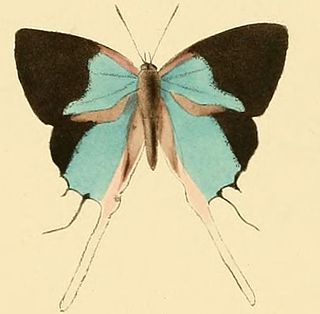A genus is a taxonomic rank used in the biological classification of living and fossil organisms, as well as viruses, in biology. In the hierarchy of biological classification, genus comes above species and below family. In binomial nomenclature, the genus name forms the first part of the binomial species name for each species within the genus.

Binomial nomenclature, also called binominal nomenclature or binary nomenclature, is a formal system of naming species of living things by giving each a name composed of two parts, both of which use Latin grammatical forms, although they can be based on words from other languages. Such a name is called a binomial name, a binomen, binominal name or a scientific name; more informally it is also called a Latin name.

Euphorbia is a very large and diverse genus of flowering plants, commonly called spurge, in the spurge family (Euphorbiaceae). "Euphorbia" is sometimes used in ordinary English to collectively refer to all members of Euphorbiaceae, not just to members of the genus. Some euphorbias are commercially widely available, such as poinsettias at Christmas. Some are commonly cultivated as ornamentals, or collected and highly valued for the aesthetic appearance of their unique floral structures, such as the crown of thorns plant. Euphorbias from the deserts of Southern Africa and Madagascar have evolved physical characteristics and forms similar to cacti of North and South America, so they are often incorrectly referred to as cacti. Some are used as ornamentals in landscaping, because of beautiful or striking overall forms, and drought and heat tolerance.

Pitcher plants are several different carnivorous plants which have modified leaves known as pitfall traps—a prey-trapping mechanism featuring a deep cavity filled with digestive liquid. The traps of what are considered to be "true" pitcher plants are formed by specialized leaves. The plants attract and drown their prey with nectar.

Loranthaceae, commonly known as the showy mistletoes, is a family of flowering plants. It consists of about 75 genera and 1,000 species of woody plants, many of them hemiparasites. The three terrestrial species are Nuytsia floribunda, Atkinsonia ligustrina, and Gaiadendron punctatum Loranthaceae are primarily xylem parasites, but their haustoria may sometimes tap the phloem, while Tristerix aphyllus is almost holoparasitic. For a more complete description of the Australian Loranthaceae, see Flora of Australia online., for the Malesian Loranthaceae see Flora of Malesia.

In biology, a monotypic taxon is a taxonomic group (taxon) that contains only one immediately subordinate taxon.

A botanical name is a formal scientific name conforming to the International Code of Nomenclature for algae, fungi, and plants (ICN) and, if it concerns a plant cultigen, the additional cultivar or Group epithets must conform to the International Code of Nomenclature for Cultivated Plants (ICNCP). The code of nomenclature covers "all organisms traditionally treated as algae, fungi, or plants, whether fossil or non-fossil, including blue-green algae (Cyanobacteria), chytrids, oomycetes, slime moulds and photosynthetic protists with their taxonomically related non-photosynthetic groups ."

Acacia, commonly known as the wattles or acacias, is a large genus of shrubs and trees in the subfamily Mimosoideae of the pea family Fabaceae. Initially, it comprised a group of plant species native to Africa and Australia, with the first species A. nilotica described by Linnaeus.

In biological classification, taxonomic rank is the relative level of a group of organisms in a taxonomic hierarchy. Examples of taxonomic ranks are species, genus, family, order, class, phylum, kingdom, domain, etc.
Iolaus parasilanus, the friendly sapphire, is a butterfly in the family Lycaenidae. It is found in Ghana, Nigeria, Gabon, the Republic of the Congo, Angola, the Democratic Republic of the Congo, Uganda, Kenya and Tanzania. The habitat consists of forests.
Iolaus theodori, the Maessen's sapphire, is a butterfly in the family Lycaenidae. It is found in Ghana and Togo.
Iolaus poecilaon, the intense sapphire, is a butterfly in the family Lycaenidae. It is found in Nigeria, Cameroon, the Republic of the Congo, the Democratic Republic of the Congo, Uganda, Tanzania and Zambia. The habitat consists of forests.
Iolaus aequatorialis is a butterfly in the family Lycaenidae. It is found in Zambia, north-western Tanzania, Uganda, the Democratic Republic of the Congo (Sankuru) and Gabon.
Iolaus dianae is a butterfly in the family Lycaenidae. It is found in Zambia.
Iolaus montana is a butterfly in the family Lycaenidae. It is found in Tanzania. The habitat consists of forests.
Iolaus ndolae is a butterfly in the family Lycaenidae. It is found in northern Zambia, Malawi, eastern Tanzania and possibly the Democratic Republic of the Congo (Shaba). The habitat consists of forests.
Iolaus pamae is a butterfly in the family Lycaenidae. It is found in north-eastern Zambia and western Tanzania.
Iolaus stewarti is a butterfly in the family Lycaenidae. It is found in north-eastern Zambia. The habitat consists of montane areas.

Iolaus timon, the long-tailed sapphire, is a butterfly in the family Lycaenidae. It is found in Guinea, Sierra Leone, Ivory Coast, Ghana, Togo, Nigeria, Cameroon, Gabon, the Republic of the Congo, Angola, the Democratic Republic of the Congo, Uganda and Tanzania. The habitat consists of forests.

Agelanthus is a genus of Afrotropical plants in family Loranthaceae. They grow in trees, including Acacia and Combretum species, as hemiparasitic shrubs of varying sizes. The host plant is penetrated by a single haustorium, and the stems typically have swollen, flower-producing nodes. The flowers are often closely clustered (fascicled) with the five petals (pentamerous) fused into a tube (gamopetalous). The flower may have a swollen base and the tubes open along unilateral, V-shaped splits. The filaments remain spirally rolled inward when the flowers open, while the styles are inconspicuous, slender filaments that are somewhat thickened in the middle. Berries range from pink to orange and red in colour, and are around 1 cm in diameter.









